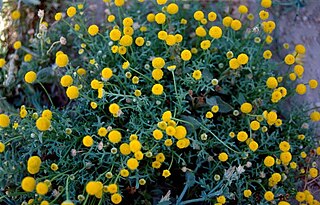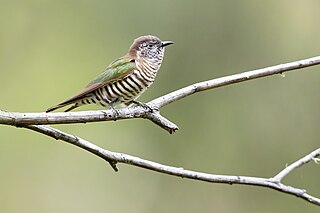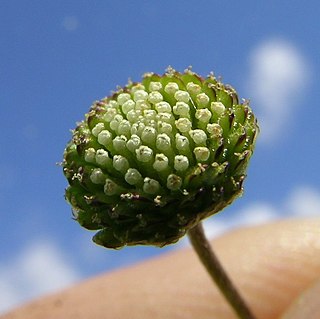
Coriaria is the sole genus in the family Coriariaceae, which was described by Linnaeus in 1753. It includes 14 species of small trees, shrubs and subshrubs, with a widespread but disjunct distribution across warm temperate regions of the world, occurring as far apart as the Mediterranean region, southern and eastern Asia, New Zealand, the Pacific Ocean islands, and Central and South America.

Craspedia is a genus of flowering plants in the family Asteraceae commonly known as billy buttons, billy balls, and woollyheads. They are native to Australia and New Zealand where they grow in a variety of habitats from sea level to the Alps. The genus is found in every state of Australia but not in the Northern Territory. In New Zealand, Craspedia is found from East Cape on the North Island south to Stewart Island. It also occurs on Campbell Island and the Chatham Islands.

Aaronsohnia is a genus in the family Asteraceae, native to mainly non-salty steppes and deserts in North Africa and Middle East. It was named in 1927 after the agronomist Aaron Aaronsohn by the botanists Otto Warburg (1859–1938) and Alexander Eig (1894–1938).

Cotula coronopifolia is a species of flowering plant in the aster family (Asteraceae). Commonly known as brass buttons, golden buttons, and buttonweed, it is native to South Africa and New Zealand.

Cotula is a genus of flowering plant in the sunflower family. It includes plants known generally as water buttons or buttonweeds.

The shining bronze cuckoo is a species of cuckoo in the family Cuculidae, found in Australia, Indonesia, New Caledonia, New Zealand, Papua New Guinea, Solomon Islands, and Vanuatu. It was previously also known as Chalcites lucidus.

Cotula australis is a species of plant in the daisy family known by the common names bachelor's buttons, annual buttonweed, southern waterbuttons and Australian waterbuttons. This small plant is native to Australia and New Zealand, but it is known in other areas of the world as a common weed.

Erechtites is a genus of flowering plants in the daisy family known commonly as fireweeds or burnweeds. They are native to the Americas and Australia, but some species are widely distributed weeds.

Anthemideae is a tribe of flowering plants in the family, Asteraceae, and the subfamily Asteroideae. They are distributed worldwide with concentrations in central Asia, the Mediterranean Basin, and southern Africa. Most species of plant known as chamomile belong to genera of this tribe.

Astelia is a genus of flowering plants in the recently named family Asteliaceae. They are rhizomatous tufted perennials native to various islands in the Pacific, Indian, and South Atlantic Oceans, as well as to Australia and to the southernmost tip of South America. A significant number of the known species are endemic to New Zealand. The species generally grow in forests, swamps and amongst low alpine vegetation; occasionally they are epiphytic.

Euchiton is a genus of flowering plants in the family Asteraceae. They are native to Australasia and the Pacific. Some have been introduced far outside their native ranges.

Anaphalioides is a genus of flowering plants in the family Asteraceae described as a genus in 1950. They are native to New Zealand and New Guinea.

Corynocarpus is the only genus of plants in the family Corynocarpaceae and includes five species. It is native to New Guinea, Australia, New Zealand, New Caledonia, and Vanuatu.

Leptinella squalida is a species of flowering plant in the daisy family, native to New Zealand. Known as "brass buttons" for its yellow button-like flowers, it grows to about 5 cm (2 in) tall, spreading indefinitely via rhizomes.

Leptinella nana or pygmy button daisy is a species of flowering plant in the family Asteraceae. It is known from only three sites in New Zealand.

Cotula alpina, also known as the alpine cotula, is a perennial herb in the family Asteraceae. It is a small flowering plant that forms ground covering mats and is well adapted to alpine environments.

Leptinella filiformis, or slender button daisy, is a species of flowering plant in the daisy family, found only in the north-eastern part of the South Island of New Zealand. Thought to be extinct by the 1980s, it was rediscovered growing on a Hanmer Springs hotel lawn in 1998, and in the wild in 2015.

Cotula turbinata is a herb in the Asteraceae family native to the Cape Province, but found in India and in Australia

Megaherbs are a group of herbaceous wildflowers growing in the New Zealand subantarctic islands and on the other subantarctic islands. They are characterised by their great size, with huge leaves and very large and often unusually coloured flowers, which have evolved as an adaptation to the harsh weather conditions on the islands. They suffer from overgrazing due to introduced mammals.

Leptinella dioica, the hairless leptinella, is a species of flowering plant in the family Asteraceae, native to New Zealand, and introduced to Ireland. A mat-forming perennial useful as a ground cover, there are a number of cultivars, including 'Minima' and 'Seal Island'.




















